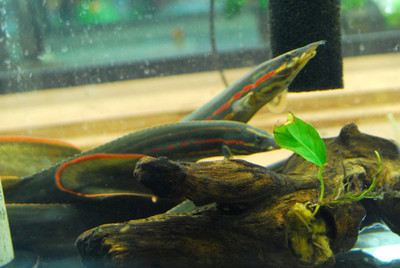Fire Eel
Posted by Max Gandara on on 6th Aug 2025
Fire Eel Care Guide
The Fire Eel is a fascinating freshwater fish known for its long, slender body, vibrant red-orange stripe along its dark body, and eel-like appearance. Despite its name, the Fire Eel is not a true eel but a type of spiny eel native to Southeast Asia’s river systems.
Origin
Fire Eels are native to the slow-moving rivers and flooded forests of Southeast Asia, including Thailand, Malaysia, and Indonesia. They prefer habitats with soft substrates and plenty of hiding places.
Appearance
Fire Eels have elongated, snake-like bodies with a black or dark brown base color accented by a bright red or orange stripe running from head to tail. Adults can reach lengths of up to 3 feet (90 cm) in the wild, though they typically grow to around 2 feet (60 cm) in captivity.
Behavior
Fire Eels are nocturnal and shy, spending much of their time hiding in caves or buried in substrate during the day. They are peaceful but can be territorial with their own kind or similarly shaped fish.
Tank Setup
* Minimum tank size: 75 gallons or larger due to their potential size and activity level.
* Provide a deep sand or fine gravel substrate for burrowing.
* Include caves, driftwood, and dense plants for hiding places.
* Maintain low to moderate lighting to mimic natural conditions.
Water Parameters
* Temperature: 75–82°F
* pH: 6.5–7.5
* Hardness: Soft to moderately hard
Diet
Fire Eels are carnivorous and require a diet rich in protein. They accept live, frozen, or sinking pellet foods such as bloodworms, earthworms, shrimp, and small fish.
Tank Mates
Suitable tank mates include large, peaceful fish that can coexist with the Fire Eel’s nocturnal habits. Avoid small fish that may be viewed as prey.
Care Tips
* Provide plenty of hiding spaces and a soft substrate for burrowing.
* Ensure a secure lid, as Fire Eels are known escape artists.
* Maintain clean water with good filtration and regular changes.
* Feed a varied, protein-rich diet to promote health.
Conclusion
The Fire Eel is an intriguing and visually striking species that adds unique interest to large freshwater aquariums. Proper care and a suitable environment are essential for their health and well-being.
---

